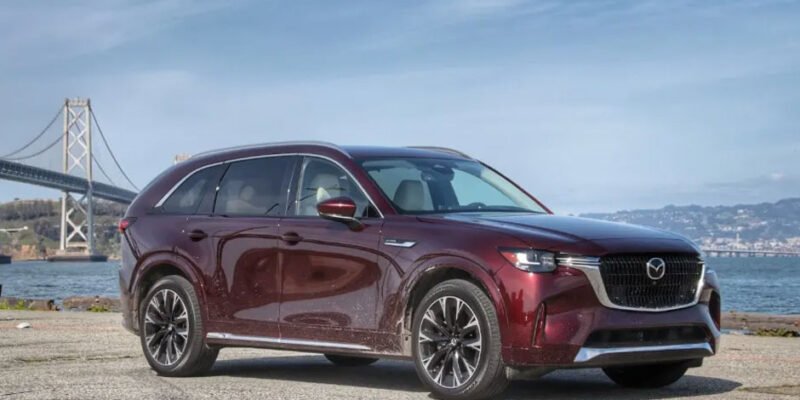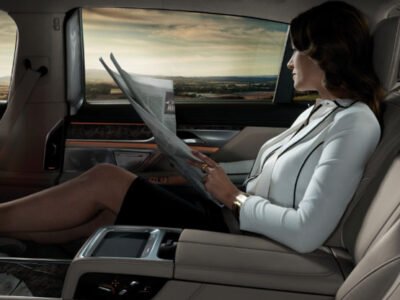Introduction
Mazda, known for its commitment to internal combustion engines (ICE), has been steadily transitioning into a more premium segment. While this shift poses challenges for a brand traditionally associated with mainstream vehicles, Mazda continues to push boundaries with its new flagship model, the CX-90 three-row crossover. The CX-90 introduces unexpected features and modifications in a market saturated with battery electric vehicles. In this article, we delve into the notable aspects of Mazda’s latest offering and explore how it distinguishes itself from competitors.
The CX-90’s Striking Features
The CX-90 replaces the CX-9 in Mazda’s North American lineup and boasts significant changes that go beyond the expected. While many automakers are prioritizing electric vehicles, Mazda takes a more cautious approach. The CX-90 marks Mazda’s foray into plug-in hybrid technology in North America, along with the introduction of an all-new inline-six cylinder engine.
Embracing Mazda’s Traditions
As Mazda positions itself as a more upscale brand, it has shifted away from the iconic “Zoom-Zoom” tagline. However, the essence of “Driving Matters” remains a key aspect of the brand’s DNA. This philosophy is evident in the CX-90’s chassis and propulsion systems. With a shift to longitudinal engine mounting, Mazda has created more space under the hood, allowing for a double control arm front suspension instead of the traditional strut layout. This modification improves wheel-turning capabilities and enhances maneuverability. Despite a longer wheelbase compared to the CX-9, the CX-90 exhibits a smaller turning circle, resulting in better agility.
Furthermore, the longer wheelbase and new suspension layout contribute to improved body control, reducing squat and dive during acceleration and braking. Passengers in the second and third rows experience a more comfortable ride, addressing one of the criticisms of the CX-9, which was known for its stiffer suspension. The CX-90 demonstrates better ride quality and handling, even on rough surfaces.
Thanks to its feature-rich design, the base CX-90 with a six-cylinder engine is approximately 300 pounds heavier than its predecessor, the CX-9. The plug-in hybrid (PHEV) variant adds an additional 200 pounds due to the inclusion of a battery. During a test drive along curvy roads in California, the CX-90 exhibited remarkable composure, comfortably navigating corners at speeds that were once deemed implausible for a vehicle of this size and type. While the PHEV felt slightly softer than the Turbo S variant, it retained Mazda’s characteristic fun-to-drive experience.
Engine Options and Performance
The CX-90 offers three propulsion options: two versions of the 3.3-liter inline-six cylinder turbo engine and a naturally aspirated 2.5-liter four-cylinder PHEV. The base 3.3-liter engine generates 280 horsepower and 332 pound-feet of torque on regular gasoline. The same engine, recalibrated for premium fuel, delivers 340 horsepower and 369 pound-feet of torque in the Turbo S variant. Both engines feature a 48V mild hybrid system, enhancing auto stop-start functionality and enabling engine off sailing at higher speeds. The Turbo S, in particular, showcases the benefits of the inline-six layout, providing balanced performance, smooth operation, and a satisfying engine note. The CX-90 offers a serene driving experience, with minimal wind and road noise on the highway. It achieved a reasonable fuel efficiency of 23 mpg during a 100-mile test drive.
The PHEV variant incorporates a 17.8-kWh lithium-ion battery beneath the floor. It powers a 100 kW (134 hp) electric motor positioned between the engine and an eight-speed automatic transmission. When combined with the engine, the system produces a total output of 329 horsepower and 363 pound-feet of torque. Despite the additional weight, the instant torque from the electric motor enhances the CX-90’s responsiveness, providing comparable performance to the six-cylinder variants. Mazda estimates an electric range of approximately 26 miles, making it suitable for most daily driving conditions.
Mazda’s Design Evolution
The CX-90 features Mazda’s “Kodo 2” design language, combining familiar elements with fresh touches. The sleek body contours exude a natural and dynamic aesthetic. The surfaces exhibit smoothness without appearing flat, akin to a pebble in a stream that has been gently polished over time. In sunlight, the curves of the CX-90 become more pronounced, creating an elegant and sophisticated look.
Notable design elements include the signature five-sided grille and slim horizontal headlamps, which have been subtly refined. While the overall dimensions of the CX-90 remain similar to the CX-9, Mazda’s new approach to engine placement has resulted in a more spacious cabin. Despite a wider center console, clever interior panel and seat shaping have improved passenger space. The previous CX-9’s limited third-row seating has been enhanced to accommodate two adults comfortably, albeit for shorter journeys.
The CX-90 offers upgraded interior appointments, particularly on the Premium Plus trim. Various material and color combinations are available, ranging from leatherette on the base Select trim to Nappa leather on the Premium Plus trim. Mazda incorporates a mix of aluminum, leather, suede, wood, and unique hanging stitch fabric, creating a distinctly Japanese feel. The caramel and black leather combination, complemented by dark wood and caramel suede accents, stood out as a personal favorite.
Comfort is paramount in the CX-90, especially in the first two rows. The Preferred trim and above feature heated and ventilated front seats, with Premium Plus adding heated second-row seats. The cabin offers six USB-C ports distributed across all rows and a Qi wireless charging pad for convenient device charging.
Cutting-Edge Technology
The CX-90 introduces Mazda’s first fully digital instrument cluster and an impressive 12.3-inch infotainment display. As with other Mazda models, touchscreens are minimized to prioritize safety and minimize distractions. Interaction with the built-in infotainment system is primarily through a large central control knob on the console. However, the display supports touch functionality when using Android Auto or Apple CarPlay, which are more conducive to touchscreen navigation.
A standout feature of the CX-90 is the driver profile setup. When creating a profile, the system prompts the driver to input their height. An infrared camera near the infotainment screen scans the driver’s eye position, automatically adjusting the seat, steering wheel, and mirrors to approximate the optimal positions for comfort, control, and visibility. The camera generates a secure hash based on facial features, similar to iPhone’s Face ID, saving the settings to the profile. Up to six profiles can be stored, each encompassing personalized audio preferences, driver assist functions, climate control settings, and more.
Pricing and Conclusion
Overall, the CX-90 represents a significant improvement over the CX-9 in various aspects. It offers enhanced comfort, improved performance and efficiency, and presents itself as a worthy competitor to luxury models like the Audi Q7 and Volvo XC90, all while maintaining a competitive price point. The Turbo Select variant starts at $40,970 (including $1,375 delivery charge) and ranges up to $61,325 for the Turbo S Premium Plus. The PHEV variant begins at $48,820 and tops out at $58,325 for the Premium Plus trim. These prices are comparable to mainstream competitors like the Hyundai Palisade, despite the added electrification.
While Mazda takes a measured approach to electrification, the CX-90 demonstrates the brand’s commitment to progress. Compared to Mazda’s initial foray into electric vehicles with the MX-30, the CX-90 presents a compelling step forward in the right direction.
















Comments